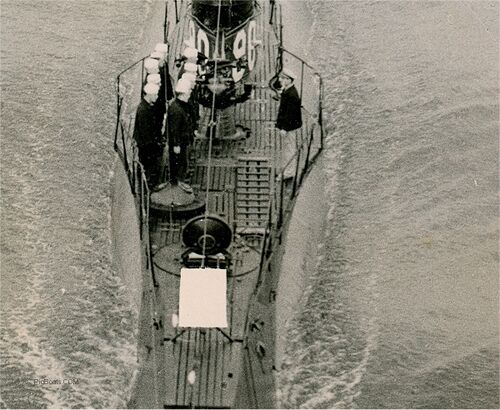R-13

Photo from the private collection of Ric Hedman

Note the one officer in the center of the photo dressed in dungarees but wearing his officer's hat. Officers would do this when work was necessary to keep their dressier uniforms clean. He might be that day's Duty Officer.
The Captain is no-doubt the officer seated on the left wearing his qualification Dolphins and a service ribbon. The officer on the right does not appear to be submarine qualified at the time the photo was taken.
Some of the men are wearing their stripes on their right sleeve and some on the left sleeve. The right arm rates were deck related jobs. The left arm rates were engineering and electrical jobs. The Navy did away with this system after WW II and placed all the ratings on the left sleeve. The hashmark for time in service was worn on the left sleeve regardless. Until recently a hashmark signified four years of continuous service. Recent changes to the Navy Regulations changed that to three years service.
The lower right corner of the photo is missing. When newspapers cleaned out their archives would many times tear this corner off so they could keep count of dispersed assets and prevent a competitor from using their copy.
Photo from the private collection of Ric Hedman

Photo from the private collection of Ric Hedman

Photo from the private collection of Ric Hedman

Photo from the private collection of Ric Hedman

Photo from the private collection of Ric Hedman

Photo from the private collection of Ric Hedman

At 8 AM a signal, usually a bugle call followed by the playing of the National Anthem, is given at the base and all vessels raise the American flag. All personnel are to stop what they are doing and face the closest visible flag and salute as the flag is raised up the flagpole. In this case the flag is already attached to the flag staff and the man is waiting for the signal to place the staff into its holder. The event is officially called "Colors".
The tent to the right is to keep rain out of the open hatch.
The sailor is wearing blues so that means the photo was taken between September 1 and May 31, otherwise he would be wearing summer whites. He has a white garrison belt and the holster for a .45 caliber, M1911A1 pistol can be seen near his right arm. The belt holds closed his heavy wool Peacoat and he is wearing a white hat under the hood of his raincoat. He is also wearing galoshes over his shoes. All in all, a nasty wet day on the Thames River.
Photo from the private collection of Ric Hedman.

Photo from the private collection of Ric Hedman.

Photo from the private collection of Ric Hedman.

Photo from the private collection of Ric Hedman.

Photo from the private collection of Ric Hedman.
Page created by:
Ric Hedman & David Johnston
1999 - 2023 - PigBoats.COM©
Mountlake Terrace, WA, Norfolk, VA
webmaster at pigboats dot com
